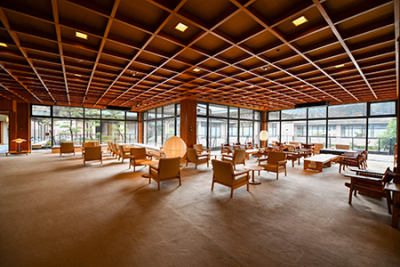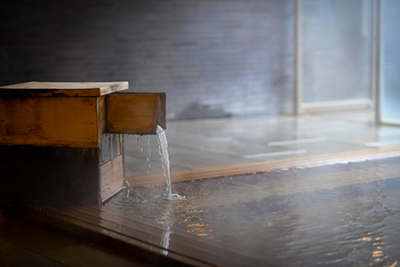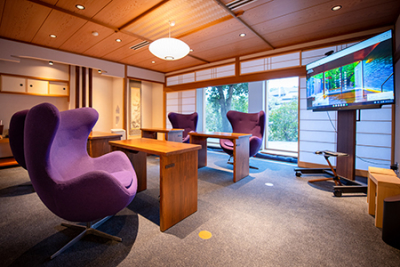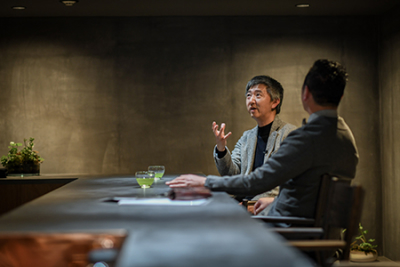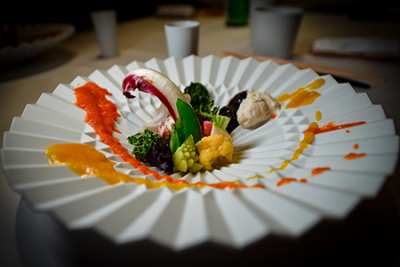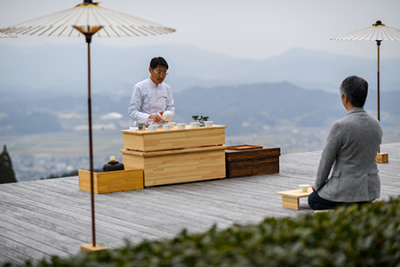Innovation Meets History at Wataya Besso

Straddling the Shiota River in Ureshino, Saga Prefecture, the Wataya Besso hotel complex spreads across the 66,000-square-meter property to offer several hot spring baths, restaurants, and a large number of luxurious guest rooms. Even before the COVID-19 pandemic struck, long-established onsen ryokan (traditional hot-spring inns) across Japan had been struggling to survive changes in society and people’s tastes. Faced with these challenges, Wataya Besso’s industry-leading initiatives are gaining attention. We talked with CEO Yoshimoto Kohara, the visionary behind innovative projects which extend beyond normal ryokan operations, including a new workcation office program that integrates all the best aspects of the ryokan, and an initiative in which the hotel serves as a hub for promoting the charm of the local area.
Innovative Staging of Space in a Historical Property
Loved for generations as an onsen ryokan in the Ureshino Onsen area, the main buildings of Wataya Besso have a solid profile that reinforce a sense of history, and invite visitors to another world. Walking under the doorway curtain brings a view of seasonally decorated platforms that invite visitors into a surprisingly modern space inspired by Japanese elements. Walking around each corner reveals more traditional-modern contrast, transforming surprise into the pleasure of anticipation. This is the world of the new Wataya Besso created by Kohara.
The scenery from the moon-viewing deck immediately outside the spacious lobby reveals the impressive size of Wataya Besso while focusing on the garden. The complex offers “a world where guests can immerse themselves in their favorite indulgences,” including a garden terrace where guests can enjoy a foot spa; a sophisticated gift shop; a Pierre Hermé sweets shop operated in collaboration with Pierre Hermé Paris, the only boutique branch in Japan to offer items made with Ureshino tea; a dedicated tea counter where customers can explore Ureshino tea; and a reading area with a carefully curated book collection.
Although Kohara created this stylish new world, our assumption that it would endure was met with a surprising response. “Yes, it looks very stylish now, but this is just the world that I designed. With the flow of time, standards will change, and anything is possible… Each generation and each management will do it their own way,” explains Kohara. His flexibility, decision-making, and power of execution resurrected an old hotel that was in danger of being washed away by the flow of time.
The new developments seen at Wataya Besso are currently leading the industry, but a difficult period when business was anything but booming helped reveal to Kohara the charms of Ureshino that he hadn’t noticed before. “Wataya Besso has a hot spring that has been flowing for 1,300 years, Ureshino tea with a history of 500 years, and gardens and buildings across a property that covers over 66,000 square meters. If we wanted to build this as a completely new complex, it would be absolutely impossible. When I inherited this property I thought it was a sinking ship, but I have come to understand how lucky I really am,” says Kohara about the turning point of his career, and how he established a style that maximizes the value of these assets.
New Projects Make Use of the Spacious Ryokan Property
The large ryokan complex is divided into different areas, each with a different style of guest room.
Guests can choose a Japanese style room with a private outdoor bath for the typical onsen ryokan experience, book a room with a panoramic-view bath in the tower wing, which was designed by celebrated architect Kisho Kurokawa, or select a Western style room. Meanwhile, there are some areas that have gone largely unused, like multiple banquet rooms that were designed for group tours, and a portion of the numerous guest rooms. Effective use of these spaces is being addressed by the development of a modern concept: the workcation. Workers with a high degree of flexibility in their workspace can stay here for mid- or long-term periods of time on a new type of room plan that includes breakfast. The updated facilities include Wi-Fi, office equipment, and co-working spaces, while offering the benefits of a typical vacation, including unlimited access to the hot spring baths during the stay. When workers feel refreshed, they are likely to be significantly more productive.
However, there are similar programs all across Japan that are already in place. Kohara has taken it one step further and remodeled some guest rooms to attract entire offices. Some offices have already relocated from distant cities like Tokyo to join the Ureshino community.
Along either side of a long hallway, next to the sliding doors of what at first glance appear to be private dining rooms, are the nameplates of offices. It’s strange, yet inviting. Inside, the neat, modern interior is home to a large monitor and a long table that was custom-made for the office by the ryokan’s carpenter from a single plank of wood. Tenants have the freedom to work together in their office space, to move to their favorite spot within the complex to focus on an idea independently, or even to sit outside on the terrace and enjoy the fresh air and garden breeze.
Some people are taking advantage of another option, a “tea subscription” offered through Wataya Besso’s original brand, “Books & Tea Sanpuku,” that combines the pleasures of reading and tea in a bookstore environment. One worker said, with a smile, that this innovative environment allows them to exhibit a level of performance beyond what they usually achieve at work.
Buying Local: Connecting with Local Businesses to Boost Value
Another major attraction of the ryokan is the food. Each restaurant on the property uses ingredients supplied through partnerships with local farms, and the chefs communicate directly with the farmers through regular visits. Then there is the tableware, which serves as a canvas to transform each meal into edible art. The restaurant Risoan orders all its tableware directly from Riso Porcelain, Ltd. in collaboration with ceramic artist and company representative Shinji Terauchi. “Arita ware has always been in high demand as a decorative item, but I want people to know that it’s also wonderful for daily use. We now have the capability to use computer graphics while discussing designs, which avoids wasted time and effort during the prototype stage, and allows us to attempt challenging new ideas,” says Terauchi about the modern designs of Risoan’s dishes that are strikingly different from traditional Arita ware. One of the first products of Japanese culture to be widely appreciated overseas, Arita ware can be said to be a pioneer of the Cool Japan concept, while continuing to evolve into modern styles using the best clay and advanced techniques.
Of course, there is more to enjoy besides dinner. Each restaurant is working on its own initiatives, such as a partnership with a local brewery to produce sake, sweets and desserts made by local pâtissiers and chocolatiers featuring ingredients that celebrate Saga Prefecture, and sales of Saga-produced cheese from local dairies. Tea lovers will already recognize Ureshino tea, and no time is lost promoting its wonderful qualities. Soejimaen operates a shop inside the bookstore where guests can enjoy reading and tea, either at counter seats at the bar or at quiet tables surrounded by bookshelves. Customers can enjoy a cup of Ureshino tea inside, or purchase tea leaves to take home.
Another way to indulge is the Chakukan (“tea space”) afternoon tea service, hosted in the tea fields in collaboration with an Ureshino tea producer. Visitors can explore premium Ureshino tea, hand-brewed by a tea master one cup at a time, in an elegant space elevated above the rolling tea fields between the mountainsides. This service evolved out of a tea tourism project, one of the first events that Kohara worked on with the local community. Innovative staging to maximize the natural potential of each element is the true power of Watada Besso.
動画のダイジェスト版はこちら



